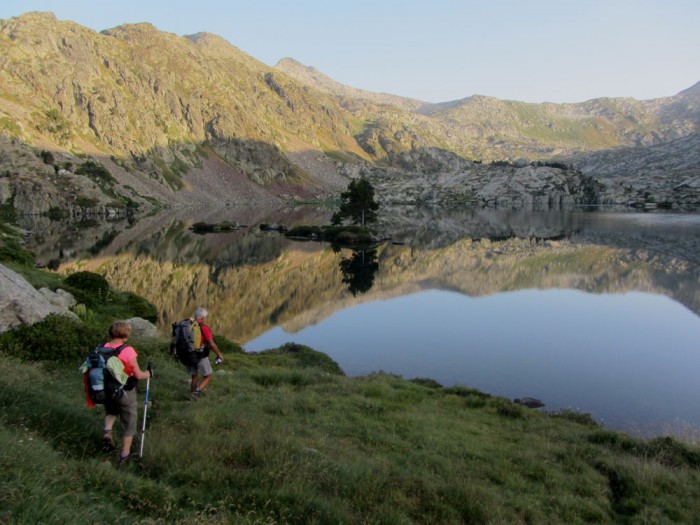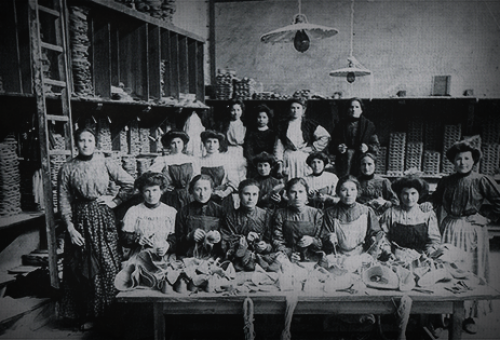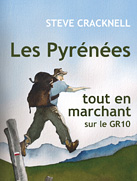Cet article est également disponible en: French
Seen from a distance, the Pyrenees are timeless, an archetype of what mountains should be. But I recognise how much my personal travelogue is full of romantic clichés. So I’ve been thinking about the reality: the ‘news from the mountains’. This is the second in a series of close-ups on how the Pyrenees are changing.
Putting aside the TGV high-speed train (2013) and the THT high tension electricity cable (2015), thankfully both underground, what is the other news?
Way of St James
The Way is no longer a just a long-distance walk; it has become a social phenomenon. Since the turn of the century the number of walkers crossing the Pyrenees on the Way has increased more than five-fold. This leg of the walk, from St-Jean-Pied-de-Port (France) to Orreaga/Roncevaux (Spain) is reputed to be one of the hardest of the trek. In 1999, 9,318 walkers had their credencial (pilgrim passport) stamped in the French office before setting off. Fifteen years later they were 53,972. [Statistics] If that figure doesn’t surprise you, consider this one: in 1978 only 13 pilgrims crossed the threshold of the cathedral in Santiago. [Historical statistics] Nobody in St-Jean-Pied-de-Port was even bothering to count.
Passing through the town once, I asked a man in the office why so many more people had taken it into their heads to walk the 800km. It isn’t that people have become more religious, he replied. It is partly the inclusion of the Way on the World Heritage List (1993), partly the shorter working week in France (2000), and partly a snowball effect: more walkers means more hostels, means shorter days, bringing in even more walkers.
Retirada

In memory of the hundreds of thousands of Spanish republicans who preferred living in exile to bowing to fascism. Plaque installed in La Vajol by the Negrín foundation 1 February 2010.
It means retreat. For sixty years very few people talked about the event but it has recently been incorporated into the canon of stories which define the mountains, particularly for Catalans.
Half a million Spanish refugees crossed the Pyrenees in 1939. So why was the Retirada forgotten? Because Franco, in power until 1975, studiously avoided drawing attention to the episode. Then, under the subsequent ‘transition’ governments the ‘Pact of forgetting’, designed to avoid recriminations, ensured that the subject was not broached.
So it was only when the last of the actual participants started to die that the Spanish started to search out their childhood memories.
Numerous memorials now decorate the frontier villages. Cross-border walks trace the routes taken. In La Jonquera the Museum of Exile was opened in 2007.
On the other side of the border, the Mémorial du Camp de Rivesaltes, north of Perpignan, opened its doors in October 2015. Successive French governments haven’t been too proud of what happened either. Rivesaltes was a reception centre for the refugees, but was only completed nearly two years after their arrival. The refugees were initially dumped on the beaches of Argelès-sur-mer and obliged to dig hollows in the sand to protect themselves from the wind – in February.

Listening to eye-witness reports of the Retirada as photos of the refugees are projected onto the walls of the Mémorial.
Maquis

In memory of Quique and Celes, fallen for freedom. The plaque was added on the 50th anniversary of their deaths in an ambush as they tried to cross the border into France. Located in the cemetery of Espolla (Catalonia)
The Spanish maquis have been rehabilitated in the last 20 years, with the Historical Memory Law, passed in 2007, providing a legal framework for a process which was already underway.
Labelled as common thieves or bandits by the police, the maquis are little-known outside Spain, even now. They continued to harass the dictatorship long after the end of the civil war, often using France as a safe haven. The last one was killed in Barcelona in 1965.
Continua Pirineum
The Continua Pirineum is a very 21st-century project. Funded by the EU, it aims to bring French and Spanish communities in the Pyrenees back together again – in the past the mountains were less of a barrier than they are now. One example amongst many:
Hirondelles
Dressed in black and arriving in flocks, like the hirondelles (swallows) which became their nickname, many young Spanish women used to cross the watershed to work for French espadrille manufacturers. Unlike the birds they went north in the autumn to return in the spring. But once communications with lowland Spain improved, the mountain paths were abandoned. See also Gérard Caubet’s Etonnantes Pyrénées.
One of the projects of the Continua Pirineum is to reopen those cross-border paths. What used to be desire paths between mountain neighbours has become a dossier on the desk of Brussels bureaucrats.
As Caubet points out, Jean Ferrat’s emblematic ‘La Montagne’ could have been written for the hirondelles.
| Ils quittent un à un le pays Pour s’en aller gagner leur vie Loin de la terre où ils sont nés… |
They leave their country one by one to go and earn their living far from where they were born… |
| Pourtant que la montagne est belle Comment peut-on s’imaginer En voyant un vol d’hirondelles Que l’automne vient d’arriver ? |
But still, the mountain is beautiful: how can one imagine on seeing a flight of swallows that autumn has just arrived. |












